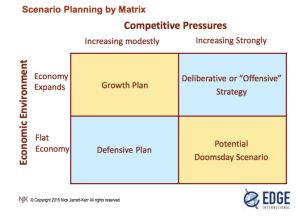Preparing for an Unpredictable Future: Scenario Planning Tips

It hardly needs saying that the future is difficult or impossible to predict. Law firm pessimists often indulge in catastrophizing many situations that they think will be threatening or disastrous to the firm. Optimists, on the other hand, may become even narcissistic in exaggerating the firm’s special market position and often over-emphasize the chances of upturns and a positive competitive environment. At the same time, complacent partners are almost always tempted to stay in their comfort zones and to assume that life will carry on much as before.
“Scenario planning” is a useful way of setting out a number of possible pictures of the future for the firm, dependent on potential changes in the market or within the firm. By scenario planning, the firm can assess the implications and influences for their preferred strategy that their view of the possible future implies. The process enables both contingency planning and the exploration of the various strategic options, and can help to lift the eyes of partners from internal obsessions to view the external horizon with a greater degree of realism. The standard approach is to view three possible scenarios – optimistic, neutral and pessimistic – which allows for a number of possibilities to be illustrated and for responsive plans to be developed.
 A slightly more nuanced version is shown by the four-box matrix in the table, which enables a comparison between two major likely changes in the market, leading to four possible scenarios to be developed. Consider, for instance, the economy in general and market competition, which provide two of the drivers of change in the future for law firms.
A slightly more nuanced version is shown by the four-box matrix in the table, which enables a comparison between two major likely changes in the market, leading to four possible scenarios to be developed. Consider, for instance, the economy in general and market competition, which provide two of the drivers of change in the future for law firms.
Ten years ago, some pessimistic experts were predicting that the legal profession would meet hugely increasing challenges from clients (on pricing and service delivery) from NewLaw Providers (using new business models) and from technology (providing a huge impetus to change). These forces have increased steadily but not at the pace that some predicted. In the UK, for instance, some experts predicted that half of the nation’s law firms would go out of business within five years, and this has not happened – only a modest reduction has occurred. Hence, it would be quite within the bounds of possibility to envisage a short to medium future in which firms experience much the same increase in competitive pressures in the next five years as has been suffered in the last. Equally, the approach of a tidal wave of competitive pressures cannot be discounted, bringing about the possibility of a potential doomsday scenario. At the same time, on an economic front, whilst the worst of the downturn seems to be over, it is difficult to predict how strongly global and local economies might recover. Hence, scenarios at both ends of the economic forecast can help firms to plan better.
The combined approach helps to suggest trends that should influence the sort of plans that might result – whether to invest and grow boldly, move aggressively, hunker down or contract and prepare for a bleak and negative climate and era for law firms.




